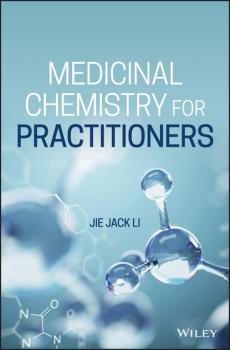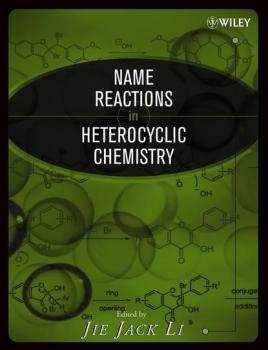ТОП просматриваемых книг сайта:
Jie Jack Li
Список книг автора Jie Jack LiАннотация
An integrated and insightful look at successful drug synthesis in today's drug discovery market The pharmaceutical industry is unquestionably vibrant today, with drug synthesis making a vital contribution. Whether in the early developmental stages of identifying and optimizing a lead, or the latter stages of process development and cost-effective scale-up, the ability to design elegant and economical synthetic routes is often a major factor in the eventual viability and commercial success of a drug. Contemporary Drug Synthesis examines how leading researchers and manufacturers have integrated chemistry, biology, pharmacokinetics, and a host of other disciplines in the creation and development of leading drugs. Authored by four of the pharmaceutical industry's most respected scientists, this timely volume: Focuses on the processes that resulted in high-profile drugs including Lipitor, Celebrex, Viagra, Gleevec, Nexium, Claritin, and over a dozen others Provides an in-depth introduction to each drug, followed by a detailed account of its synthesis Organizes the drugs into fourteen therapeutic areas for clarity and ease of use Process chemists provide an essential bridge between chemistry and the marketplace, creating scientifically practical drug processes while never losing sight of the commercial viability of those processes. Contemporary Drug Synthesis meets the needs of a growing community of researchers in pharmaceutical research and development, and is both a useful guide for practicing pharmaceutical scientists and an excellent text for medicinal and organic chemistry students.
Аннотация
Covers important name reactions relevant to heterocyclic chemistry The field of heterocyclic chemistry has long presented a special challenge for chemists. Because of the enormous amount and variety of information, it is often a difficult topic to cover for undergraduate and graduate chemistry students, even in simplified form. Yet the chemistry of heterocyclic compounds and methods for their synthesis form the bedrock of modern medicinal chemical and pharmaceutical research. Thus there is a great need for high quality, up-to-date, and authoritative books on heterocyclic synthesis helpful to both the professional research chemist as well as the advanced student. Name Reactions in Heterocyclic Chemistry provides a one-stop repository for this important field of organic chemistry. The primary topics include three- and four-membered heterocycles, five-membered heterocycles including indoles, furans, thiophenes, and oxazoles, six-membered heterocycles including quinolines, isoquinolines, and pyrimidines, and other heterocycles. Each name reaction is summarized in seven sections: Description Historical perspective Mechanism Variations and improvements Synthetic utility Experimental References Authored by a team of world-renowned contributors – some of whom have discovered the very reactions they describe – Name Reactions in Heterocyclic Chemistry represents a state-of-the-art resource for students and researchers alike.
Аннотация
A valuable addition to the literature by any measure and surely will prove its merit in years to come. The new knowledge that arises with its help will be impressive and of great benefit to humankind. —From the Foreword by E. J. Corey, Nobel Prize Laureate An invaluable guide to name reactions and reagents for homologations Name Reactions for Homologations, Part I of Wiley's Comprehensive Name Reactions series comprises a comprehensive treatise on name reactions for homologations. With contributions from world-recognized authorities in the field, this reference offers an up-to-date, concise compilation of the most commonly used and widely known name reactions and reagents. Part I discusses Organometallics, Carbon-chain Homologation, and Radical Chemistry. Arranged alphabetically by name reactions, the listing provides: Description of the reaction Historical perspective A mechanism for the reaction Variations and improvements on the reaction Synthetic utilities of the reaction Experimental details References to the current primary literature Armed with this invaluable resource, both students and professionals will have at their fingertips a comprehensive guide to important mechanisms and phenomena in homologation.
Аннотация
A valuable addition to the literature by any measure and surely will prove its merit in years to come. The new knowledge that arises with its help will be impressive and of great benefit to humankind. —From the Foreword by E. J. Corey, Nobel Prize Laureate An invaluable guide to name reactions and reagents for homologations Name Reactions for Homologations, Part II of Wiley's Comprehensive Name Reactions series comprises a comprehensive treatise on name reactions for homologations. With contributions from world-recognized authorities in the field, this reference offers an up-to-date, concise compilation of the most commonly used and widely known name reactions and reagents. Part II discusses Rearrangements, Asymmetric C-C Bond Formation, and Miscellaneous Homologation Reactions. Arranged alphabetically by name reactions, the listing provides: Description of the reaction Historical perspective A mechanism for the reaction Variations and improvements on the reaction Synthetic utilities of the reaction Experimental details References to the current primary literature Armed with this invaluable resource, both students and professionals will have at their fingertips a comprehensive guide to important mechanisms and phenomena in homologation.
Аннотация
This practical, well-organized reference delves deeply into functional group transformations, to provide all the detailed information that researchers need. Topics are organized into the following sections: oxidation, reduction, asymmetric synthesis, and functional group manipulations Each section includes a description of the functional group transformation, the historical perspective, mechanisms, variations and improvements on the reaction, synthetic utilities and applications for the reaction, experimental details, and references to the primary literature Contributors are well-known and respected for their work on the specific name reactions.
Аннотация
The Art of Drug Synthesis illustrates how chemistry, biology, pharmacokinetics, and a host of other disciplines come together to produce successful medicines. The authors have compiled a collection of 21 representative categories of drugs, from which they have selected as examples many of the best-selling drugs on the market today. An introduction to each drug is provided, as well as background to the biology, pharmacology, pharmacokinetics, and drug metabolism, followed by a detailed account of the drug synthesis. Edited by prominent scientists working in drug discovery for Pfizer Meets the needs of a growing community of researchers in pharmaceutical R&D Provides a useful guide for practicing pharmaceutical scientists as well as a text for medicinal chemistry students An excellent follow-up to the very successful first book by these editors, Contemporary Drug Synthesis, but with all new therapeutic categories and drugs discussed.
Аннотация
This book covers all aspects of the medicinal chemistry of the latest drugs, and the cutting-edge science associated with them. Following the editors’ 3 successful drug synthesis books, this provides expert analysis of the pros and cons of different synthetic routes and demystifies the process of modern drug discovery for practitioners and researchers. Summarizes for each drug: respective disease area, important properties and SAR (structure-activity relationship), and chemical synthesis routes / options Includes case studies in each chapter Illustrates how chemistry, biology, pharmacokinetics, and a host of disciplines come together to produce successful medicines Explains the advantages of process synthesis versus the synthetic route for drug discovery
Аннотация
Sets forth the history, state of the science, and future directions of drug discovery Edited by Jie Jack Li and Nobel laureate E. J. Corey, two leading pioneers in drug discovery and medicinal chemistry, this book synthesizes great moments in history, the current state of the science, and future directions of drug discovery into one expertly written and organized work. Exploring all major therapeutic areas, the book introduces readers to all facets and phases of drug discovery, including target selection, biological testing, drug metabolism, and computer-assisted drug design. Drug Discovery features chapters written by an international team of pharmaceutical and medicinal chemists. Contributions are based on a thorough review of the current literature as well as the authors' firsthand laboratory experience in drug discovery. The book begins with the history of drug discovery, describing groundbreaking moments in the field. Next, it covers such topics as: Target identification and validation Drug metabolism and pharmacokinetics Central nervous system drugs In vitro and in vivo assays Cardiovascular drugs Cancer drugs Each chapter features a case study, helping readers understand how science is put into practice throughout all phases of drug discovery. References at the end of each chapter serve as a gateway to groundbreaking original research studies and reviews in the field. Drug Discovery is ideal for newcomers to medicinal chemistry and drug discovery, providing a comprehensive overview of the field. Veterans in the field will also benefit from the perspectives of leading international experts in all aspects of drug discovery.
Аннотация
Enables researchers to fully realize the potential to discover new pharmaceuticals among heterocyclic compounds Integrating heterocyclic chemistry and drug discovery, this innovative text enables readers to understand how and why these two fields go hand in hand in the effective practice of medicinal chemistry. Contributions from international leaders in the field review more than 100 years of findings, explaining their relevance to contemporary drug discovery practice. Moreover, these authors have provided plenty of practical guidance and tips based on their own academic and industrial laboratory experience, helping readers avoid common pitfalls. Heterocyclic Chemistry in Drug Discovery is ideal for readers who want to fully realize the almost limitless potential to discover new and effective pharmaceuticals among heterocyclic compounds, the largest and most varied family of organic compounds. The book features: Several case studies illustrating the role and application of 3, 4, 5, and 6+ heterocyclic ring systems in drug discovery Step-by-step descriptions of synthetic methods and practical techniques Examination of the physical properties for each heterocycle, including NMR data and quantum calculations Detailed explanations of the complexity and intricacies of reactivity and stability for each class of heterocycles Heterocyclic Chemistry in Drug Discovery is recommended as a textbook for organic and medicinal chemistry courses, particularly those emphasizing heterocyclic chemistry. The text also serves as a guide for medicinal and process chemists in the pharmaceutical industry, offering them new insights and new paths to explore for effective drug discovery.










